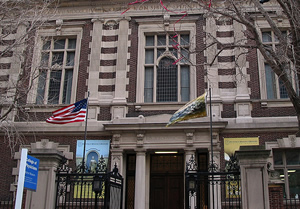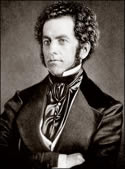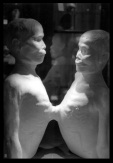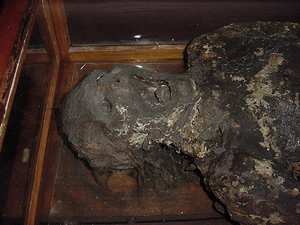
Tucked away on a side street of Philadelphia is a little known gem for fans of the strange and bizarre. In a city known for its Museum of Art, the Franklin Institute, and the Academy of Natural Sciences, the Mütter Museum of the College of Physicians of Philadelphia stands alone as a hidden treasure for those visiting the area. But be forewarned, it is not for the squeamish or easily upset. Housed in a sophisticated, high-ceilinged 19th-century building, the museum contains a collection of medical oddities, anatomical and pathological specimens, and antique medical equipment. Imagine an Ivy-League inspired "Ripley's Believe it or Not."
The Mütter Museum was founded to educate future doctors about anatomy and human medical anomalies. This original function has long been dead. Medicine is no longer taught from dried dissections, or from wax models of skin diseases and casts of human reproductive organs, at least not in the United States. Today, people are intrigued by the Museum's examples of nature's challenges to human life. The collection now proudly displays more than 20,000 extraordinary artifacts, all of which support the museum's goals: to uphold the heritage of medicine while teaching visitors about their human existence.

In 1858, Dr. Thomas Dent Mütter, a retired professor of surgery at Jefferson Medical College, offered his personal museum to the College of Physicians of Philadelphia. Mütter had assembled an exceptional collection of medical materials for use in his classes. He thought of the college as "the body best qualified by the character of its members and the nature of its pursuits for undertaking the trust." Along with the collection he donated $30,000, roughly equivalent to $800,000 today. This money was to be used to pay for the salaries of a curator and a lecturer, and also to build his already large collection. Mütter also stipulated that a requirement for accepting the money was for them to build a museum to house his contribution. The College accepted Dr. Mütter's offer in 1859, two months before he died at age 48. In 1863, the museum had its first real home at 13th and Locust Streets later to be moved to its current home on 22nd Street, between Chestnut and Market.
The Mütter Museum was truly transformed from just an seemingly odd collection that few people knew or even cared about into a nationally recognized museum by its late, great director, Gretchen Worden. Her diligent and selfless work saw the visitor's log grow from several hundred visitors a year to over 60,000 annually. Philadelphia-born magician Teller of "Penn and Teller" had this is to say of her work, "She transformed the Mütter from a collection of bones into a work of art that spoke for itself. It was still a serious academic venture, and to serious students it really told you a lot about the history of medicine. She welcomed other kinds of interest, though. For photographers and artists, it became about the beauty and horror of nature."
Headlining these one-of-a-kind treasures are exhibits like the "Bunker Twins," the "Soap Lady," and Joseph Hyrtl's infamous collection of skulls. Each has an interesting story unto itself.

As visitors enter the lower gallery, their eyes become fixed on the "Bunker Twins." The twins named Chang and Eng, were born in Siam (now Thailand). They were joined at the chest by a small piece of cartilage. Discovered by British merchant Robert Hunter, they traveled throughout the United States staging appearances and making speeches. They managed to live rather normal lives, marrying sisters and fathering 22 children between the two of them. They became famous and because of their notoriety the term "Siamese twins," though not very politically correct, is still used to describe conjoined twins. The museum displays their preserved connected livers and a plaster cast of their torsos showing the band of skin and cartilage that joined them at the chest.
Ascending to the upper gallery, visitors immediately come face to face with the "Soap Lady." She has been on display in the Museum for over 100 years. She was allegedly found by workers removing bodies from an old burial yard. Her body was buried in soil with certain chemical properties that transformed her fat deposits into a soapy substance called adipocere. She is forever preserved in a mummified state, with her mouth opened in a silent but penetrating scream.

Turning to their right visitors are struck by what seems to be an endless wall of skulls staring at them out of the dark, hollow holes where their eyes once rested. Prominent Viennese anatomist Joseph Hyrtl sold his enormous collection of skulls from around the world to the museum in 1874, a purchase that legitimized the Mütter as an accredited medical museum. This assortment is believed to be the home of the skull of Wolfgang Amadeus Mozart along with the casts of the skulls of Beethoven and Schubert.
The Mütter Museum illustrates a multitude of stories and displays like these. Miss Worden said it best when describing the museum's exhibits. "While these bodies may be ugly, there is a terrifying beauty in the spirits of those forced to endure these afflictions." She wanted the world to understand that the human condition is not something to be scared or frightened by, even when damaged and distorted in horrific ways. The startling collection offered by the museum allows visitors an opportunity to truly experience some of the ways in which the advancement of medicine has made treatments possible for some and has made life easier for many. Since its founding the Mütter's collection shave taken medical oddities out of the Freak Shows of the past and have given them, and the means of their treatment, the respect and attention they deserve.
Sources:
- Booker, Bobbi. "Mütter Museum Gives Graphic Anatomy Study." Philadelphia Tribune 25 May 2008: 1D.
- Detweiler, Margit. "Not With My Mütter You Don't." Philadelphia Citypaper 18-25 July 1996. 5 May 2009 <http://www.citypaper.net/articles/071896/article012.shtml>.
- Mütter Museum. 2005. The College of Physicians of Philadelphia. 22 Mar. 2009 <http://www.collphyphil.org/Site/mutter_museum.html>.
- Quigley, Christine. Skulls and Skeletons: Human Bone Collections and Accumulations. Jefferson, NC: McFarland, 2001.
- Sims, Gayle Ronan. "Gretchen Worden, Mutter Museum chief." Philadelphia Inquirer 4 Aug. 2004: B7.
- UNC University Libraries. 18 Oct. 2007. University of North Carolina. 14 Mar. 2009 <http://www.lib.unc.edu/ncc/gallery/twins.html>.
- Worden, Gretchen. Mütter Museum of the College of Physicians of Philadelphia. New York: Blast Books, 2002.
